Spotted thick-knee
The spotted thick-knee (Burhinus capensis) also known as the spotted dikkop or Cape thick-knee, is a wader in the family Burhinidae. It is native to tropical regions of central and southern Africa.
| Spotted thick-knee | |
|---|---|
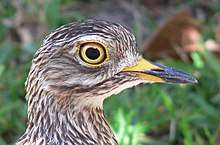 | |
_(32680086412).jpg) | |
| Scientific classification | |
| Kingdom: | Animalia |
| Phylum: | Chordata |
| Class: | Aves |
| Order: | Charadriiformes |
| Family: | Burhinidae |
| Genus: | Burhinus |
| Species: | B. capensis |
| Binomial name | |
| Burhinus capensis (Lichtenstein, 1823) | |
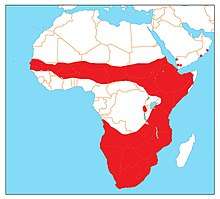 | |
| range | |
Description
The spotted thick-knee, which can reach up to 45.5 cm (17.9 in) in height, has long legs and brown-and-white speckled plumage which provides camouflage, making it difficult to spot the bird in the grasslands and savannas where it roams. Its head is large and round with a prominent yellow eye and a short, stout beak. When in flight or standing in a characteristic position with its wings raised, it shows a striking contrasting pattern. Its legs are long and yellow and the tibiotarsal joint is expanded, giving it the name "thick-knee".[2][3]
Behaviour
The spotted thick-knee is nocturnal and squats on the ground during the daytime, making it difficult to spot. It hunts exclusively on the ground, feeding on insects, small mammals and lizards.
Breeding
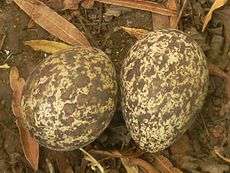
It nests on the ground, lining a scrape with grasses, feathers, pebbles and twigs. The female typically lays two eggs, and males and females rear the offspring together, with both bringing food back to the nest. The birds will defend the nest and adopt a defensive pose with wings spread and tail cocked and will even peck an intruder. Sometimes they will fake injuries to lead predators away from the nest.[2][3]
Distribution
The spotted thick-knee is native to the grasslands and savannas of sub-Saharan Africa. Its range extends from Senegal, Mali and Mauritania in the west to Ethiopia, Kenya, Tanzania and South Africa in the east and south.[1]
Status
The spotted thick-knee has a very extensive range, and its population is believed to be stable. For these reasons, the IUCN has rated it as being of "Least Concern".[1]
Gallery
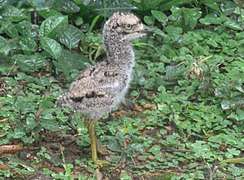
A five day old chick 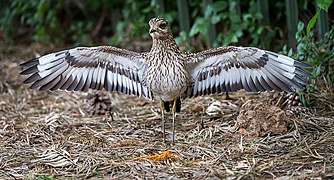
Adult's defensive pose 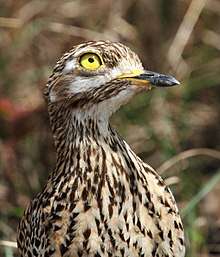
Scanning the sky for raptors _cooling_down_by_panting_..._(32236049388).jpg)
Cooling down by panting
References
- BirdLife International (2012). "Burhinus capensis". IUCN Red List of Threatened Species. 2012. Retrieved 26 November 2013.CS1 maint: ref=harv (link)
- "Spotted Dikkop Fact Sheet". Lincoln Park Zoo. External link in
|website=(help) - Broekhuysen, GJ (1836). A description and discussion of threat- and anxiety-behaviour of Burhinus capensis (Lichtenstein) during incubation. Brill Archive. pp. 240–1.
- Keith, Stuart; Urban, Emil K.; Fry, C. Hilary (1986). The Birds of Africa, Volume II. Academic Press. pp. 204–205. ISBN 0-12-137302-9.
External links
| Wikimedia Commons has media related to Burhinus capensis. |
| Wikispecies has information related to Burhinus capensis |
- BirdLife species factsheet for Burhinus capensis
- "Burhinus capensis". Avibase.

- "Spotted dikkop media". Internet Bird Collection.
- Spotted thick-knee photo gallery at VIREO (Drexel University)
- Interactive range map of Burhinus capensis at IUCN Red List maps
- Audio recordings of Spotted thick-knee on Xeno-canto.
- Spotted thick-knee Species text in The Atlas of Southern African Birds
